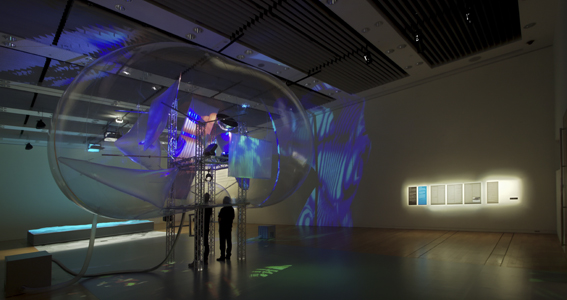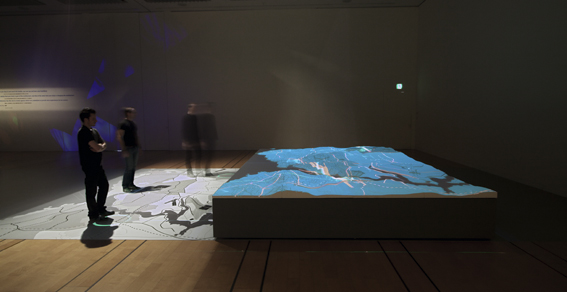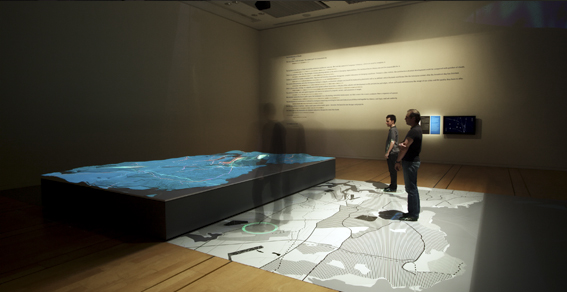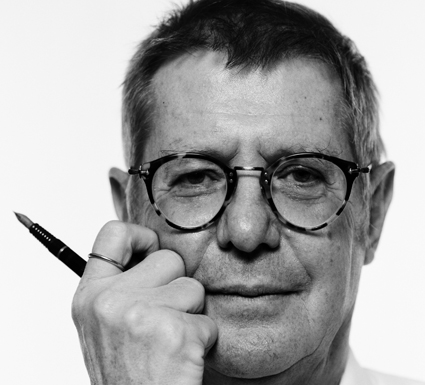by Owen Schaefer
Bringing architectural ideas into the gallery frequently seems to result in one, or all, of three things: miniature reconstructions, scale models under glass, or photographs lined up along the walls―none of it terribly satisfying or visceral. Architecture, after all, is about buildings, and buildings simply have to be seen and walked through. Fortunately, none of this happens when the NTT Intercommunication Center brings works by architectural group Coop Himmelb(l)au into its space. But then, what happens isn’t quite architecture either.
For Coop Himmelb(l)au (the ‘Coop’ pronounced ‘co-op’―the short form of co-operative), architecture is as much about space as it is about putting physical walls around that space. Founded by Wolf. D Prix, Helmut Swiczinsky and Michael Holzter in 1968, the Viennese group foresaw that architecture was moving out of the hands of municipal urban planning and into the realm of private building projects. They felt that private and public spaces would need to be redefined, and connected in more organic ways if a sense of public space was to survive at all.
In the practical sense, this led to the breaking up of typical compartmentalized rooms and the usual geometrics of buildings, while walkways, open corridors and sometimes open air shafts connect structures to the environment around and within them. It’s a building vision that has led to dozens of signature constructions around the world, including the twister-like BMW Welt building in Munich and the weightless loft of the Busan Cinema Center.
But where practicality leaves off and theory begins, we get the ICC’s Future Revisited―two examples of conceptual works which hark back to the underlying, if still-academic, principles upon which much of the Coop’s philosophy is built.
Astro Balloon 1969 Revisited―Feedback Space, as one might guess by the ‘revisited,’ is based on an idea conceived early on: an architectural structure that would not only resemble something akin to an internal organ, but would react to its inhabitants as an extension of their own bodies, blurring the lines between inside and outside, self and home, and perhaps even self and other.
The 1969 concept never went past the model stage, but for last year’s Venice Biennale of Architecture, the group built a scaled-back version of their vision―a small balloon-like structure for two which reads the heartbeats of its ‘inhabitants’ and translates them to sound and visuals on the inside. The installation, moving away from its initial science-fiction concepts and aiming at current technologies, is really more of a heart-rate screening room. But that notion of a living-space that reads your rhythms and responds to them is tantalizingly close, and stepping into the space of your own heartbeat is a curious sensation in itself.
More conceptual still is Brain City Lab―the product of a larger collaborative effort based on an essay by neurologist Wolf Singer, who compared the structure of the human brain to the structure of a city. In Brain City Lab, viewers walk across the map of a fictional land area as a computer collects data about their positions and movements, using it to draw and re-draw ever-shifting lines and forms, which could be the roads, borders or power grids of a virtual city. The immediate visual connections are not direct or even clear, but the project aims to use the data it collects to influence new concepts in city planning―an idea that does seem to beg the question of how relevant the movements of gallery visitors are to the construction of any city…no matter how virtual. So whether your footsteps will one day build cities is still a question for the future.
Show: Coop Himmelb(l)au: Future Revisited (to Dec. 23)
Gallery: NTT Intercommunication Center (Hatsudai station)
Hours: 10am–6pm (closed Mon)
Admission: ¥500
Tel: 03-5353-0900 www.ntticc.or.jp
Photo credits:
Wolf D. Prix, photo © Elfie Semotan
Other Photos © Markus Pillhofer












